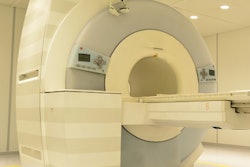
Using a simulated clinical decision analysis model, researchers from the University of California, San Diego (UCSD) make a case for the cost-effectiveness of intraoperative MRI for patients with high-grade gliomas in a study published online March 26 in Radiology.
The calculations, based on a multitude of variables, showed that intraoperative MRI "reliably maximizes" results from glioma resection and provides patients with an average of 1.5 additional months of progression-free survival, compared with surgery performed with neuronavigation systems. While intraoperative MRI was more expensive, it was more cost-effective than neuronavigation technology when adjusted for a patient's postsurgery quality of life years.
"Our data suggested that surgeons should not be deterred from using intraoperative MRI in patients at advanced age or at the end of life," wrote lead author Peter Abraham and UCSD colleagues. "Intraoperative MRI remained cost-effective for patients with a probability of one-month survival close to zero."
An extensive amount of research has shown the value of intraoperative MRI to improve patients' outcomes after resection for a variety of cancers, including high-grade gliomas. Despite this clinical success, some concern remains over the cost-effectiveness of intraoperative MRI.
To get a better handle on cost versus outcome for high-grade gliomas, the UCSD researchers designed a computer model to simulate individual patients undergoing treatment for the disease from the time of their initial tumor resection until their death. The model took into consideration a patient's age, clinical status, and treatment regimen, along with adverse effects of the therapy, added expense of intraoperative MRI, costs incurred by the patient, and postprocedure longevity and quality of life.
"These parameters were randomly generated for each patient, but they always exist within ranges specified by randomized controlled data," the authors explained. "By comparing patients treated by using intraoperative MRI with those not treated with it, cost-effectiveness of this modality can be assessed."
The model compared 100,000 patients who underwent intraoperative MRI with 100,000 patients who were treated with neuronavigation systems. The difference between the two approaches is that the neuronavigation systems do not provide surgeons with real-time intraoperative images, as MRI does. For the cost-effectiveness evaluations, the researchers chose a willingness-to-pay threshold of $100,000 per quality-adjusted life year (QALY) for each patient. The dollar amount coincides with previously published oncologic cost-effectiveness research.
While intraoperative MRI was $13,447 more expensive than neuronavigation, the modality achieved an incremental benefit of 0.18 QALYs per patient and an average of 1.5 additional months of progression-free survival, the researchers found. The model also figured an incremental cost-effectiveness ratio of $76,442 per QALY, which means intraoperative MRI had a 99.5% chance of cost-effectiveness based on the willingness-to-pay threshold of $100,000 per QALY.
| Intraoperative MRI vs. neuronavigation for patients with high-grade gliomas | |||
| Neuronavigation | Intraoperative MRI | Difference | |
| Cost | $163,013 | $176,460 | $13,447 |
| QALY | 1.16 | 1.34 | 0.18 |
As for its future clinical potential, the researchers suggested that intraoperative MRI could become "exceedingly cost-effective" as use of the modality expands to other oncology-related procedures, including the resection of less intrusive low-grade gliomas. Mobile intraoperative MRI scanners also could "prove to be cost-effective if used as ancillary outpatient MRI units when not in the operating department," they added.



















